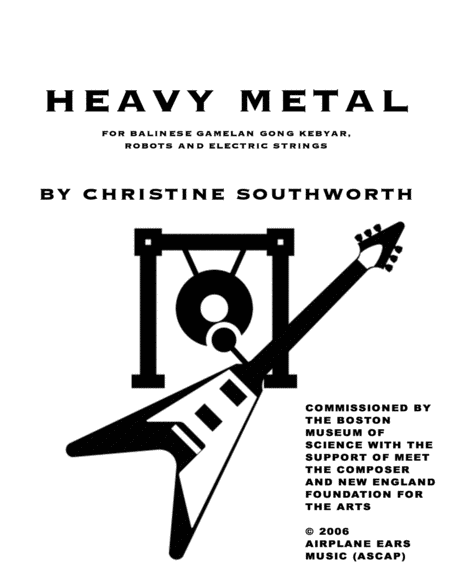Small Ensemble Bass Guitar,Violin - Level 4 - Digital Download SKU: A0.1013048 Composed by Christine Southworth. Contemporary,World. Score and parts. 76 pages. Airplane Ears Music #5802059. Published by Airplane Ears Music (A0.1013048). HEAVY METAL (2006, 18') for Balinese Gamelan Gong Kebyar, guitar, violin, bass, lyricon, and robotic instruments. Commissioned by the Boston Museum of Science with the support of NEFA and Meet the Composer. Premiered on Wednesday, January 25, 2006 at Cahner's Theater in the Boston Museum of Science as part of Music & The Invasion of Technology, performed by Gamelan Galak Tika, Blake Newman, Erik Nugent, Todd Reynolds, and Eddie Whalen. Heavy Metal represents a new kind of fusion, multi-dimensional, making connections across cultures acoustic and electronic, western and eastern, high and low, human and machine. The piece was written for Gamelan Galak Tika, a Balinese gamelan in residence at MIT that has worked with electric instruments many times in the past, but this is certainly the first time a traditional Balinese gamelan has shared the stage with robotic instruments. In other ways, though, there is something very natural about these combinations: they reflect the way we all experience music in the 21st century. It could also be argued that this is simply an extension of the way music has always progressed and changed, as Chinese shawms morphed into oboes, and exotic middle eastern percussion instruments, like the cymbal and triangle, worked their way into the symphony orchestra. Heavy Metal engages the full force of two ensembles, Galak Tika and Ensemble Robot, as well as a living history of electroacoustic instruments, from the vintage lyricon to the Whirlybot. The sounds implicit in both senses of the title find their way into new combinations of struck bronze and excitable circuitry. Heavy Metal is based on American hard rock music from the late 1970’s through the early 1990s. The idea started as a pun, because the keys of many Balinese gamelan instruments are made of metal, but when I began studying the melodic ideas and rhythms in heavy metal music, I found that they leant themselves very well to gamelan. The problem was that a gamelan has a very specific sound and limited timbral variation, the sounds of hit metal and skin. I feel that the sounds of the gamelan become much more interesting when combined with string sounds. Also, the gamelan uses a pentatonic scale so I am using western instruments and robots to expand the sound universe to a full spectrum. In this piece, the gamelan and the western/robotic instruments play separately – rhythmically they are together, and they are working through the same material at the same time, but the western instruments and robots do not play the 5 notes that the gamelan plays, and more often than not they stay out of that key (a variation of E Major, the gamelan tuning being C#, D#, E, G, and A) altogether. This creates a sense of two harmonic worlds co-existing and cooperating, the West and our technology with Bali and their technology, much more primitive but very powerful nonetheless.About the ComposerChristine Southworth (b. 1978) is a composer and video artist based in Lexington, Massachusetts, dedicated to creating music born from a cross-pollination of sonic ideas. Inspired by intersections of technology and art, nature and machines, and musics from cultures around the world, her music employs sounds from man and nature, from Van de Graaff Generators to honeybees, Balinese gamelan to seismic data from volcanoes. Website: www.kotekan.com
